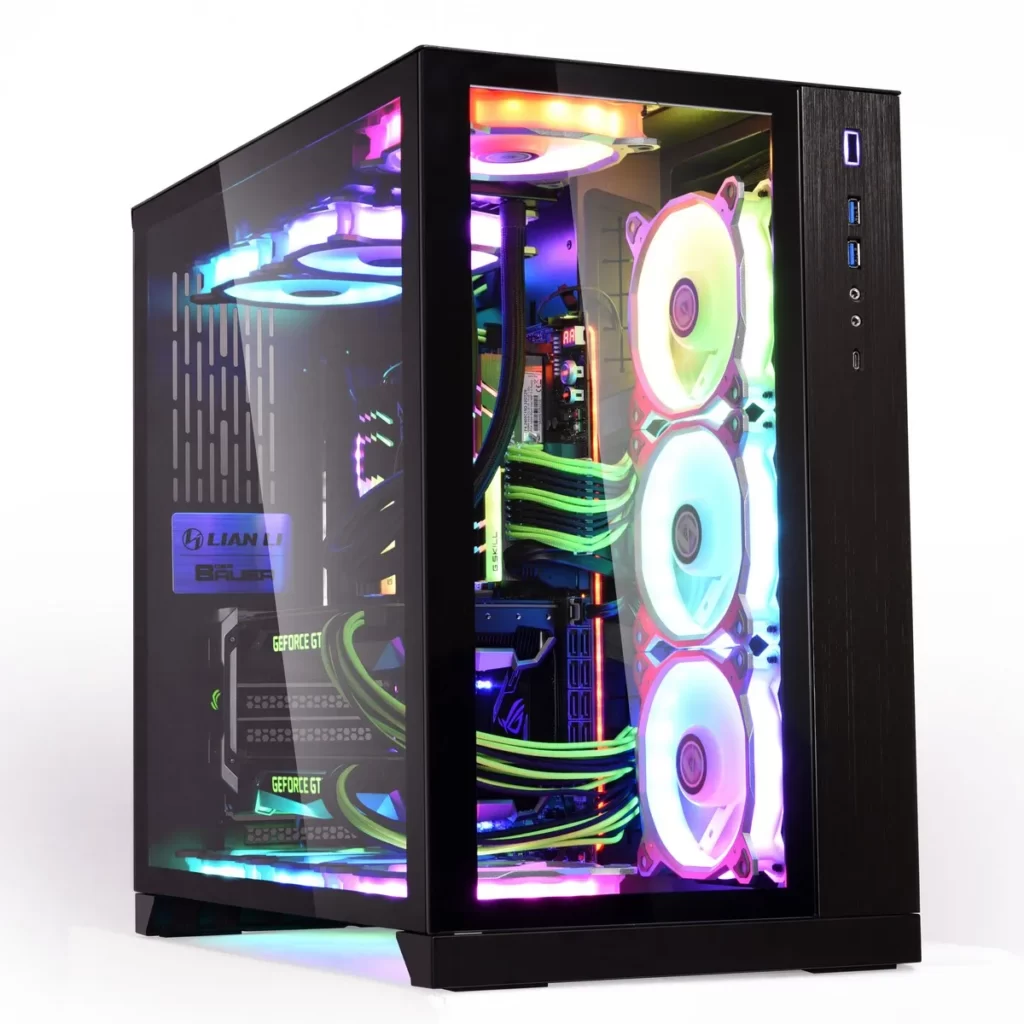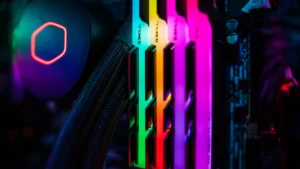Choosing a computer case will not directly increase your PC performance, but it is an important part of the overall experience. If you have ever built a PC, you know. When entering the world of computers, and specifically gaming PCs, picking a computer case may seem like a simple activity. A good computer case should be elegantly designed, with great ventilation and easy installation.
Compatibility of components with the PC case
I’m sure you’re wondering, “how do I pick a PC Case?” Well, we’re here to guide you. When it comes to your choice of PC Cases, there are tons of options. Not only do you have to think about the other components you have, but you also need to factor in how much space you have.
One of the most important factors to consider when choosing a case is motherboard compatibility. If you have an ATX motherboard, a larger ATX case will be compatible, while a smaller mATX case is compatible with both motherboards.
Another important thing is compatibility with the graphics card and CPU cooler. Here, too, there is nothing to be afraid of – manufacturers of GPUs and CPU coolers provide the dimensions of their products, and the specification of most cases includes compatible components. The stairs start as soon as you choose water cooling. You will not find information everywhere about what heat sink will fit on the front or top panel. The safest solution is to choose a larger PC Case.
And the last aspect regarding the components, i.e. the power supply. Although in this case, the likelihood of a mistake is the smallest, you still have to take into account its size – especially if you want to choose a smaller housing. There are two sizes of power supplies – ATX and SFX, the former being larger and more popular. Both of these formats fit most cases, while only SFX will fit into smaller designs.
So much for the compatibility inside the case. However, you must not forget where the desktop will stand. Under the desk or on the desk? Depending on where you plan to place the computer, carry out the dimensions of the selected place and on this basis choose the appropriate case size.
Your Criteria
When choosing between the different types of PC cases to build your gaming rig, you have to know what it is that you want to achieve. The main thing to consider is the ideal space and functionality since not every single product will combine the 2 elements seamlessly into one.
Some people choose loud cases that will stun their friends, while others want more neutral colors and designs. What kind of person are you?
Types of PC Cases
Before we dig deeper into the main categories of enclosures, we need to address the subject of sizes and structures. The most important benefit of this division is providing a clear way to determine whether specific components fit in the enclosure or not. This eliminates guesswork when choosing a PC case, which is very important when building a system.
There are several types of PC Cases, but we look at the most popular and interesting types: Full Tower cases, Mid Tower cases, Mini-ITX cases, and finally Cube-type PC Case.
Full Tower
When choosing a Full Tower PC case, like Corsair Graphite Series 780T White in most cases you do not have to worry about compatibility with components. It can even accommodate powerful 420mm liquid-cooled heatsinks. You can fit ATX and SFX power supplies into such cases. When it comes to motherboards, the vast majority of these models will accommodate the following formats
- EATX
- ATX
- Mini-ITX
- microATX
Designed for large-scale rigs with multiple graphics cards, massive storage, and liquid cooling systems, they can turn even the biggest desk space into a purpose-built gaming computer.
MidTower
A perfect case for any heavy-duty or gaming enthusiast, PC cases are the most popular designs available. These have an internal and external structure that gives optimum protection to the hardware components used inside them, along with that they also house a number of features that other such cases lack. The most commonly compatible formats are:
- ATX
- Mini-ITX
- microATX
Professional-grade Middle Tower Cases like the Corsair 5000D can be used by gamers, office workers, and professionals alike. This PC Case accommodates two graphics cards and most tower coolers.
Mini Tower
The mini-tower, such as the Fractal Design Meshify C Mini is a low-cost case size used in home and business computers that aim for compatibility and low cost. It is smaller than the standard ATX case, but there are some standards that need to be followed by all cases in this size such as mounting points for CPU coolers being 120mm, and standard PSUs for this size being of the ATX power supply form factor.
- Mini-ITX
- microATX
Mini tower PC cases are perfect for multimedia computers, however, they can also be found in office computers. Each mini-tower has four slots for expansion cards and can hold graphics cards up to 350mm long! These cases come in all sorts of colors and patterns and will improve the look of any computer.
Cube-type PC Case
Cube-style PC cases have got small form factors that are smaller in size, and motherboards can be stacked on the case’s base. Since they are very flexible in terms of expandability, they may fit in Micro-ATX or Mini-ITX specifications. The maximum length of your graphics card can be about 300 mm. Cube-type PC cases, such as the Fractal Design Node 304, resemble a cube in shape.


What should the PC Case contain?
Once you determine the type and size of the PC case you’d like to purchase, there are a few things to consider prior to making your final decision. Power supply, dust filters, cooling, front panel, and able management system are some of the main factors to think about when choosing the right PC Case.
One way to ensure a quality power supply is to choose a well-known brand
When selecting a computer case that will house your PC, don’t settle for something that comes with an already installed PSU. These units almost always leave components vulnerable to physical tampering and can even pose a fire hazard. It is definitely better to buy a new power supply of well now brands like Corsair RM750x 80 PLUS Gold.
Choosing the location of the power supply is crucial because this component produces heat, and if the opening for its air exhaust isn’t well-positioned, this heat can cause the other parts of your PC case to overheat.
We recommend buying a case with a power supply mounted on the bottom of the case, with the fan facing downwards, outside the case. The power supply is mounted on the top of the case, with the fan facing inside the case can overheat, and overall they increase the temperature of all components.
Dust filters
The PC Case must be well ventilated, otherwise, air does not circulate properly and the components of your PC get hot and don’t work at full capacity. Dust is one of the main culprits which can lead to overheating and failure of hardware components. Therefore, it is worth paying attention to whether the PC Case has filters at all, in what number, and in which places. Dust filters are a common feature in high-quality cases and can be made from mesh, flimsy foam, or very sturdy metal.
To ensure high-quality performance, it’s important to keep your computer dust-free. Every major case manufacturer includes a dust filter with every case they sell, as it’s basically a necessary part of any case design. You can find them on the front, as well as underneath your power supply.
Cooling
Fans are very effective in cooling when they move a large volume of air over heatsinks or radiators. Fans come in different sizes and configurations, which is why you must think about the type of PC Case you plan to use, the way you would prefer your components to perform, and how quiet you expect your computer to be.
Larger fans (e.g. 140mm) achieve the same airflow level as smaller models (e.g. 120mm or 90mm) while rotating more slowly, and thus are able to force more air into the PC Case or draw out more air from it, depending on the direction of rotation. If you are looking for the best case fan, we suggest taking a closer look at Noctua’s range.
Front panel
The ports on your computer case depend on your needs. USB ports, as well as microphone and headphone connectors, are standard these days. If you’re a photographer or a video editor, you’ll need an SD card reader. Some people also install revolution controllers to easily control the speed of their fans, too.
Cable management system
The cable management system is responsible for the organization of the cables to ensure proper air circulation inside the computer case. It consists of holes in the walls of the case and special guides that are responsible for supporting and organizing cables inside the system, eliminating clutter and disorganization within the system unit.
When you choose a PC Case that offers a view of the interior, you will have a choice – acrylic or tempered glass. A major drawback with acrylic is the potential scratching, which can ultimately diminish its appearance. Conversely, tempered glass does not scratch easily and therefore retains a better look over time, which adds to the overall durability of the system as well as its longevity. While it is more expensive than acrylic, tempered glass is ultimately seen as the way to go.
Unusual PC Case
There are many different types of enclosures to choose from, including those that make a statement. If you want something simple use one of the standard cases. If you want to be different go for one of the many specialty enclosures like Antec TORQUE.





